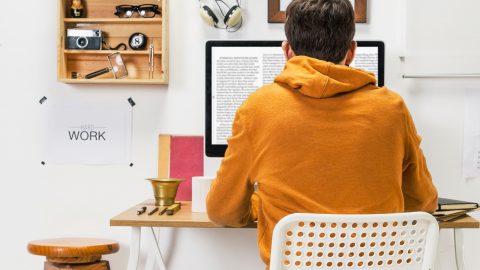You might be tempted to give yourself a big pat on the back just for hauling yourself out of bed and making it to class, but the reality is that if you’re not making best use of lecture time, you might as well have just stayed under the covers.
100% lecture attendance means nothing if you spend the duration deciding what to have for dinner. And while listening intently is definitely useful for getting a first, taking decent notes that you can refer back to when writing essays and exams is even more crucial.
Here’s a few tips from us on how to master the art of taking lecture notes!
1. Don’t write down every single word

This is an easy mistake that most of us have made at some point when taking lecture notes. Not only is attempting to get everything down on paper pretty much impossible, but it also means you won’t really be listening to what’s being said or giving yourself time to let it sink in. The key is striking a balance – listen up, and jot down particular phrases you think are important. You can then back these up with the lecture slides, which should be made available once the class is over.
2. Record lectures

If you’re a slow writer or struggle a bit with taking notes, record lectures is a good back-up in case you’re worried about missing anything. You can re-live the fun and listen to your lecturer’s dulcet tones later on, making more notes in your own time instead of trying to multitask during class. Don’t use a recorder as a replacement for paying attention or taking some notes, though – a bit of note-taking helps you process useful information. Pressing record and settling down to catch a few Zs isn’t how it works! Most smartphones come with recording features these days.
3. Pay attention

Hi there! Still with us? Even if you’ve managed the magic eight hours of sleep, it’s easy to lose concentration in a boring lecture. Beware that zoning out in class just means more time catching up on what you missed later on, or becoming frustrated because you don’t understand something. By keeping yourself focused in lectures, you’ll feel better knowing that you don’t have to catch up later on. A coffee before class might work for some, but you should always make sure you’re feeding yourself the right brain fuel to keep you going.
4. Highlight, underline and capitalise

By underlining and using CAPITALS, it’s easier to make out key points in your lecture notes. If your lecturer is stressing something important, drawing attention to certain words or phrases in whatever way you see fit will help you remember how important it is – but don’t get too distracted with your artistic creations. Using different colours and highlighters are also known to do the trick (as well as generally making your pages of notes look more exciting), but it’s probably best to add these after class when you’re reading over your notes again.
5. Use abbreviations

These are your notes – they aren’t going to be marked and the only person who needs to be able to read them is you. So, take some time to work out whatever shorthand code you’re comfortable with and roll with it. Shorten words like using ‘2′ instead of ‘to’, ‘too’ and ‘two’, or ‘da’ for ‘the’; ‘w/’ for ‘with’, etc. Whatever floats ‘ya’ boat! As long as you can understand your notes, it doesn’t matter if they’re spelled incorrectly or shortened down. Make sure you really can understand them though! You’ll have to consult them again at exam time, so don’t go too overboard with it.
6. Get rid of distractions

If you’re using a laptop or tablet for your note-taking, make sure you get rid of any possible distractions before class starts (generally we would recommend taking notes by hand, but some people do prefer to type). Close all other tabs or programs you have running and turn the WiFi off so you’re not tempted to check social media or get distracted by notifications.
You might think it’s useful to have WiFi on in case you have to look something up that you’re not sure about, but believe us – now is not the time! Just take note of what you want to look further into and you can have a browse after the lecture. Otherwise, you’ll end up off on a mad Wikipedia tangent and have no idea what’s been going on for the last half an hour.
7. Leave gaps

If you miss something that was said or find something a bit confusing (or were simply too busy thinking about your dinner again), just leave a gap so you can add the information later. This will draw your attention to certain areas that need closer attention, and leave you some extra space to delve into them later on.
8. Share and share alike

If you’ve got some nice mates on your course, there’s no harm in sharing your lecture notes afterwards, or asking to see someone else’s. There’s always a chance that one of you has picked up something vital that the others have missed, or that you’ve come up with a good way of simplifying something that’s quite complex. It’s also a nice thing to do, which earns you good points with karma, and means you’re reprocessing the information as you read other people’s notes. Not everyone likes sharing notes though, so if a classmate turns you down don’t be offended!
Courtesy of Save the Student.












